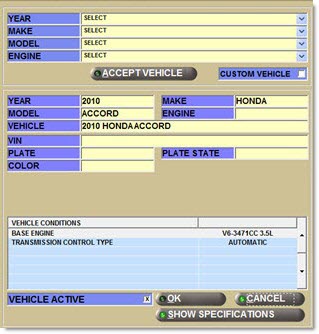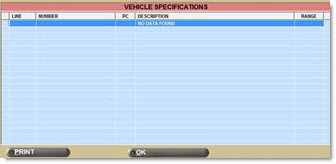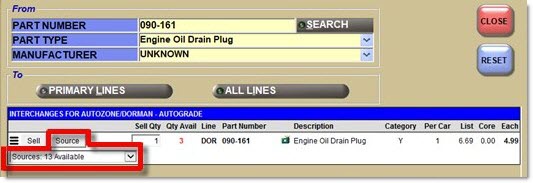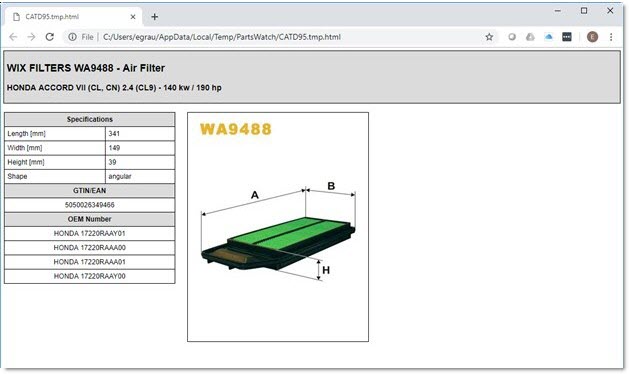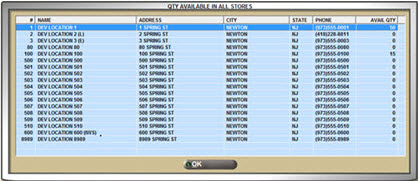TecAlliance Catalog Access
The TecAlliance Catalog is a European catalog for PartsWatch's European users. PartsWatch provides access to this data at point of sale by clicking the 'Catalog' button. The catalog is used to search for specific vehicle parts by selecting the year, make, model and engine of the vehicle, and the group, subgroup, and part type of the part. TecAlliance Catalog functionality is available during Mode 2 when the network and Catalog database servers are up but the application server is down.
The Catalog screen is accessed one of three ways.
-
Menu Path: Invoicing, Invoice Screen, Invoice screen, 'Catalog' button, Catalog screen
-
Press 'Alt' + 'G' from the Invoice screen.
-
Press 'F6' keyboard key or click 'F6' hot key button in lower screen border from any screen.
Note: When 'F6' is used, the default Cash Account and its pricing is used since no customer account number was entered.
When accessed from the Invoice screen, the Catalog screen displays with the cursor positioned at the 'Make' field. The following screen is illustrated with the 'Menu' button selected.
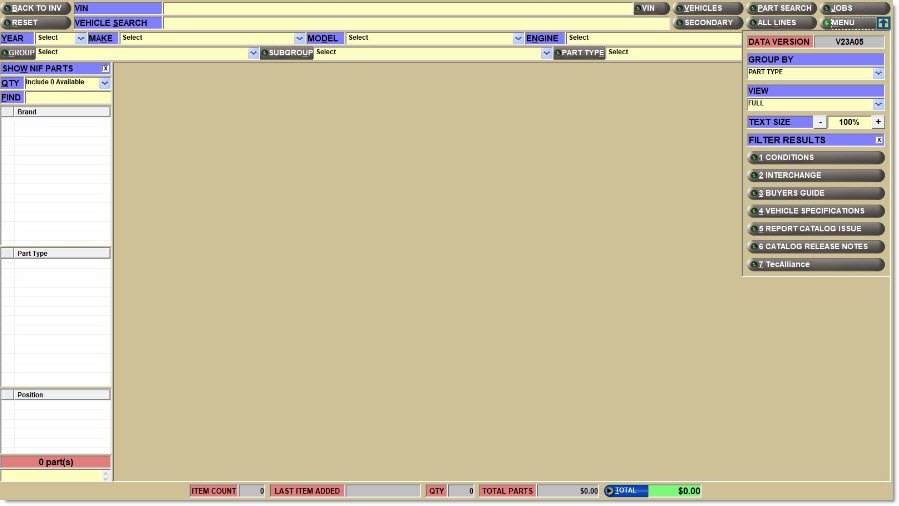
![]() TecAlliance Catalog Setup - 12 minutesTecAlliance Catalog Setup - 12 minutes
TecAlliance Catalog Setup - 12 minutesTecAlliance Catalog Setup - 12 minutes
![]() TecAlliance Catalog Usage Part 1 of 2 - 10 minutesTecAlliance Catalog Usage Part 1 of 2 - 10 minutes
TecAlliance Catalog Usage Part 1 of 2 - 10 minutesTecAlliance Catalog Usage Part 1 of 2 - 10 minutes
![]() TecAlliance Catalog Usage Part 2 of 2 - 10 minutesTecAlliance Catalog Usage Part 2 of 2 - 10 minutes
TecAlliance Catalog Usage Part 2 of 2 - 10 minutesTecAlliance Catalog Usage Part 2 of 2 - 10 minutes
All of the fields used to select the application and vehicle for a part lookup in Cataloging are drop-down boxes.
To select an item in the 'Year', 'Make', 'Model', 'Engine', 'Group', 'Subgroup', and 'Part Type' lists, use one of the following methods:
-
Single-click an item in a list to select that item and move to the next field.
-
Enter the two-digit number next to the selection to move to the next field.
-
Enter the first letter of the item desired to skip through the list. The focus is on the first line that has the letter typed. From that position, use the down arrow key to move to the next selection of the same letter. Press Enter or a right arrow to move to the next field.
-
Arrow down or up to a selection and press Enter or the right arrow to move to the next field.
The following is an example of a populated Catalog results screen.
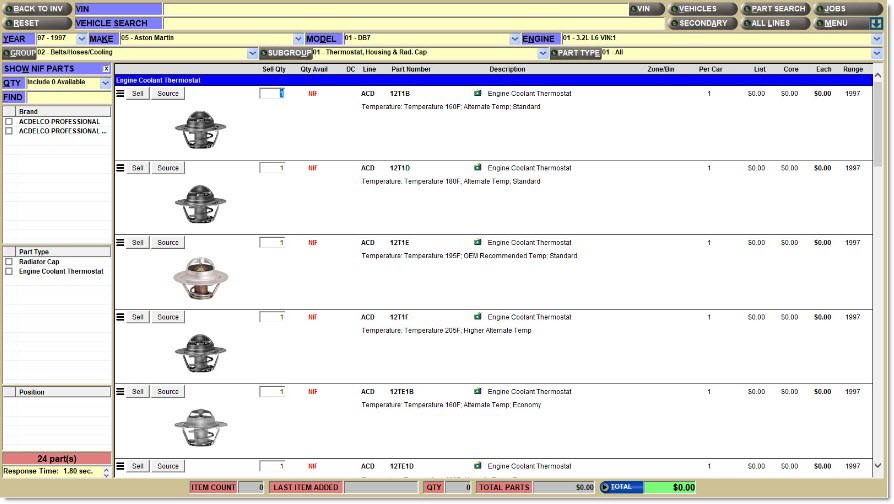
Back to Inv
Returns to the Invoice screen, when clicked. Accelerator key is 'Alt' + 'B'. When exiting to the Invoice screen by either of these two methods, a return to the Catalog from the current account/invoice redisplays the Catalog as the Catalog displayed when the 'Back to Inv' button was clicked.
VIN / License Plate
Allows entry of a Vehicle Identification Number (VIN) to look up a vehicle. Entry of a VIN with a single match populates the 'Year', 'Make', 'Model', and 'Engine' choices. Entry of a VIN with multiple matches displays a pop-up for selection of the desired vehicle.
Also allows entry of a license plate (2-character state, followed by an optional space and then the plate #). If a plate is found, the VIN replaces the plate number in the field and populates the 'Year', 'Make', 'Model', and 'Engine' choices.
Note: In order to use the plate lookup feature, it must be enabled and the username and password must be entered in the System General Setup screen.
Allows entry of a Vehicle Identification Number (VIN) to look up a vehicle. Entry of a VIN with a single match populates the 'Year', 'Make', 'Model', and 'Engine' choices. Entry of a VIN with multiple matches displays a pop-up to select the desired vehicle.

If using PW Mobile, the VIN button may also be clicked to display a list of vehicles that have had their VIN numbers scanned.
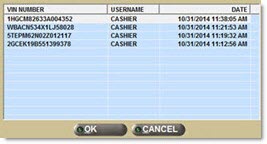
Vehicles
Displays the 'Vehicle' window with a list of previously viewed cars for this account, in order from most recent to older lookups. Although the button is not disabled, access to vehicle information is not available in Mode 2. The window automatically tracks the vehicles that have been looked up for a particular customer. Vehicles may also be manually added to that customer's list.
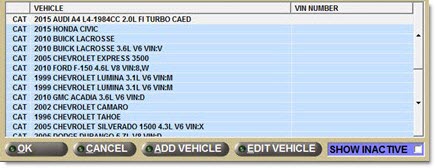
After selecting 'Year', 'Make', and 'Model' from the drop-downs, or after selecting a vehicle from the 'Vehicles' list that does not have a saved engine, and the 'Auto Select "Don't Know" Engine' field in the Store Catalog Options, is checked, the 'Engine' is automatically set to 'Don't Know'. When the 'Auto Select "Don't Know" Engine' field is unchecked, a selection must be made. Accelerator key is 'Alt' + 'V'.
Part Search
Displays a 'Part Search' pop-up to do multiple searches in one session and select multiple part types regardless of the groups or subgroups they belong to, and have all resulting parts display in the Catalog screen at one time, when clicked. Accelerator key is 'Alt' + 'P'.
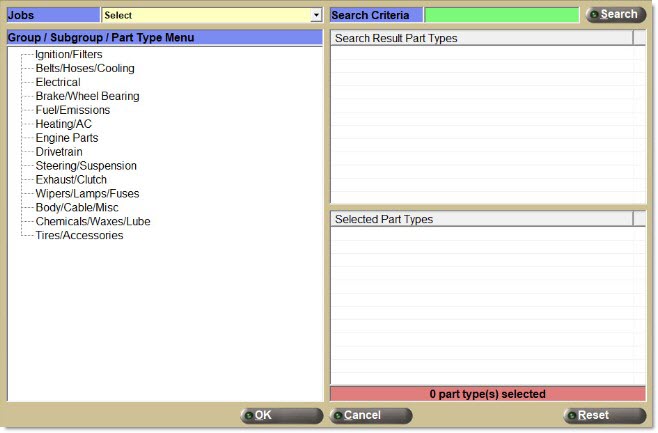
Click the 'Part Search' button to display the 'Part Search' window used to do multiple searches in one session and select multiple part types regardless of the groups or subgroups they belong to, and have all resulting parts display in the Catalog screen at one time. The 'Part Search' pop-up has a three-level menu that allows selection of multiple 'Groups', 'Subgroups', and 'Part Type' directly from the menu in the pop-up.
Jobs
Allows selection of a previously set up "job" that is made up of parts that are usually sold together for a single fix.
Menu
Displays additional buttons to filter the part search.
Options are:
-
'Vehicle Country' - Allows changing of the country of the vehicles that are returned from the catalog results.
-
'Part Country' - Allows changing of the country of the parts that are returned from the catalog results.
-
'Group By' - Sorting and grouping of items in the Catalog screen is determined by two settings:
-
The setting the store chose for the 'Catalog Group by QOH' in the Store Catalog Options screen.
-
The setting selected in the 'Group By' option from the Catalog screen.
-
'Group By' options are:
-
'Catalog Brand' (Default)
-
'Store Line Code'
-
'Part Type'
-
-
Three factors determine the grouping and sorting of results:
-
Primary Grouping: 'Group By' selection
-
Secondary Grouping: 'Catalog Group by QOH' in the Store Catalog Options screen. When checked, items are grouped by 'QOH' for all three 'Group By' options. Positive in stock quantity lists first, and then parts with a zero or negative 'QOH' and then NIF items (unless 'Hide NIFs' button is set to hide them). When unchecked, the 'QOH' is not a factor.
-
Final Sort: Final sort will be 'Part Type' if the primary grouping was 'Catalog Brand' or 'Store Line Code'.
-
Final sort will be 'Store Line Code' if primary grouping was 'Part Type'.
-
-
Even though they do not have a part type, other parts such as alternates, supersedes, and VCOs may also display as a result of the filtering when associated with a catalog part.
-
-
'View' - Allows changing the view of the screen, with the options of 'Full' and 'Compact'. When set to 'Full', the catalog includes descriptive text from the catalog under each part. When set to 'Compact', the catalog does not include descriptive text.
-
'Text Size' - Increases (+) or decreases (-) the text size of the catalog results. 100% is the minimum size and default setting. Fewer items display at one time when set to a larger text size.
-
'Filter Results' - When checked, the filter panel on the left side of the screen displays. When unchecked, the filter panel will be hidden. Note: If filters are selected and then the user unchecks the 'Filter Results' checkbox, results will still be filtered.
-
'Interchange' - Displays the 'Interchange' window to allow location of a comparable part for the requested part. Button displays only when Interchange functionality is enabled.


-
'WHI ACES' - Displays the Catalog screen that accesses the WHI ACES Catalog. Accelerator key is 'Alt' + 'T'. Button displays only when ACES functionality is enabled.
-
Note: If there are multiple catalogs set up, the button becomes a toggle button to select the different catalogs.
-
Type in the 'Year', 'Make', and 'Model' of the vehicle they are searching for.
Note: The 'Year' must be entered first, either the full four digits or the final two digits.
Note: The search is a begins with search, so accurately type in the 'Make' and 'Model' of the car for desired results.
Reset
Clears selections and catalog results quickly to start a new search.
Find
Filters parts containing the entered text in the following fields:
-
Mfg Labels
-
Footnotes, which includes:
-
'Position' - Displays in blue standard text and contains info such as front, rear, left and right. Position can also be used to designate which part something is attached to or referring to. For example: for a pulley, the position could be 'Smooth Pulley' or 'Grooved Pulley'.
-
'Attribute' - Displays in blue standard text.
-
'Qualifier' - Displays in blue italic text.
-
'Description' - Displays either the part type description from the Catalog or the PartsWatch inventory description. The description that displays depends on the 'Catalog Desc on Screen' setting set up in the Store Catalog Options screen.
-
Press 'Enter' to display items based on entered text. Click the 'X' to clear the entered text.
Primary
Displays the primary lines (lines added to the primary UDCF) in the results. (Displays by default when Catalog screen is first accessed.)
Access to the UDCF setup web pages to set lines as primary is via the Catalog Vendor Setup screen.
Secondary
Displays the secondary lines (lines added to the secondary UDCF) in the results, when clicked. When the vehicle is changed, the results default back to the 'Primary Lines'.
Access to the UDCF setup web pages to set lines as secondary is via the Catalog Vendor Setup screen.
All Lines
Displays the 'All Catalog Lines' pop-up with a list of all lines that carry parts in the group/subgroup selected. Accelerator key is 'Alt' + 'L'.''
The 'All Lines' button displays the 'All Catalog Lines' window in which all the lines that are valid for the selected group/subgroup, year, make, and model are listed. Lines that are currently selected via the Catalog Vendor Setup screen and then logged in to the UDCF setup display either as a 'Primary Line' or a 'Secondary Line', which results in red text. Lines that have not been selected in the Catalog Vendor Setup screen display in black text. An additional line or lines can be selected for display by clicking the checkbox in the far left column and clicking 'Ok'.
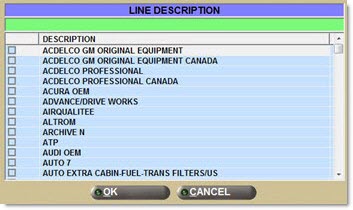
Show NIF Parts
Hides or shows NIF items.
-
Checked - NIF parts are shown in the catalog results.
-
Unchecked - NIF parts are not shown in the catalog results.
The default is based on the 'Show NIF Parts By Default' flag on the System Catalog Options screen.
Show Kits
Checkbox that determines whether or not Kit parts are shown at the top of the Catalog results.
-
Checked (default) - Kit parts are shown at the top of the Catalog results, in the 'Related Kits' section.
-
Unchecked - Kit parts are not shown at the top of the Catalog results, in the 'Related Kits' section.
Make
Displays the make of the vehicle. Required to conduct a successful part lookup. Accelerator key is 'Alt' + 'K'.
Model
Displays the model of the vehicle. Required to conduct a successful part lookup. Accelerator key is 'Alt' + 'D'.
Engine
Displays the engine size of the vehicle. Displays 'Don't Know' when the 'Auto Select "Don't Know" Engine' field is checked in the Store Catalog Options screen. When the engine size is selected, only parts that match that engine display. Accelerator key is 'Alt' + 'N'.
Displays the overall range of categories that are available for an application. Required to conduct a successful part lookup. Accelerator key is 'Alt' + 'G'.
If '00 - Multiple' is selected, a pop-up displays which lists groups that can be selected via a checkbox. Multiple groups can be selected at a time.
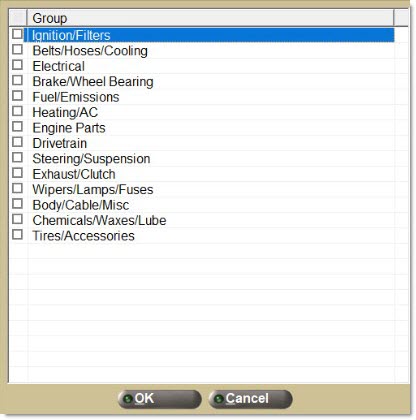
Displays a breakdown of the broader range of part type descriptions or subgroups. Required to conduct a successful part lookup. Accelerator key is 'Alt' + 'U'.
Automatically displays the 'Part Type' drop-down after selecting a subgroup.
If '00 - Multiple' is selected, a pop-up displays which lists subgroups that can be selected via a checkbox. Multiple subgroups can be selected at a time.
If '00 - Multiple' was selected for the 'Group' drop-down, and one or multiple 'Groups' were chosen, then the 'Subgroup' list will only list 'Subgroups' that exist within those selected Groups.
Note: If enough 'Groups' are selected to result in 100 or more 'Subgroups' in the 'Subgroup' list, and digits are typed in to select a 'Subgroup' (rather than selecting with a mouse), the first 'Subgroup' beginning with those digits will be selected. For example, if "10" is typed then 'Subgroup' 10 will be automatically selected and the cursor will move to 'Part Type'. In order to select "100" use the mouse.
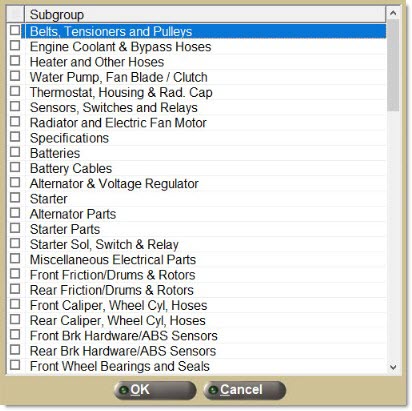
Part Type
Displays the part type. The 'Part Type' drop-down automatically displays when a subgroup is selected or changed in the 'Subgroup' field. Defaults to 'Select'. A selection is required.
Options are:
-
A single part type
-
Part type '01 - All' to select all part types (Option does not display when a search was performed using the 'Part Search' window, accessed from the 'Part Search' button.)
-
Part type '02 - Multiple' to select multiple part types. The 'Part Type' window displays to select from the multiple part types.
To select a different set of multiple part types after multiple selections are made and Catalog results display:
-
Click 'Part Type', or
-
Click 'Select' from the drop-down, and then select '02 – Multiple' again to reopen the pop-up.
-
Click the 'Part Type' button to display part types associated with the 'Group' and 'Subgroup' selections.
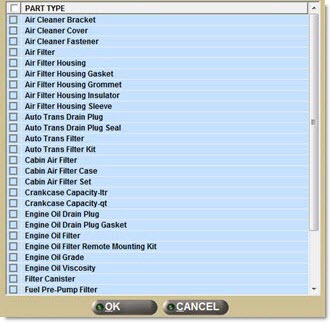
Click the header checkbox to select all part types or click individual part type checkbox(es).
Note: If enough 'Subgroups' are selected to result in 100 or more 'Part Types' in the 'Part Type' list, and digits are typed in to select a 'Part Type' (rather than selecting with a mouse), the first 'Part Type' beginning with those digits will be selected. For example, if "10" is typed then Part Type 10 will be automatically selected. In order to select "100", use the mouse.
Catalog Results Grid
Displays the Catalog results.
Displays a menu pop-up use to quickly access additional screens and functions, when clicked.
Sells a part, when clicked.
Displays and populates the 'Insufficient Quantity - Sourcing' (Quick Sourcing) screen enabling a selected Catalog part to be sourced from another location or vendor. When completed, the Catalog screen redisplays with all previous selections ('Year', 'Make', 'Model', 'Engine', 'Group', 'Subgroup', and 'Part Type') retained.
Sell Qty
Indicates the quantity to sell for the line selected.
To sell a part:
-
Press 'Enter' to sell the default quantity of the part indicated in the field or,
-
Press 'Shift' + 'Tab' to access the 'Sell' or 'Source' buttons for that item to sell or source a part (without using the mouse).
-
Enter a sell quantity other than the default quantity and then click 'Sell' or press 'Enter' to sell the item.
Enter 'L' and the number of lost sales, 'B' and the number of back orders, or 'E' for Core Exchange.
The maximum sell quantity is 32767. When a number greater than 32767 is entered, the message "Invalid Sell Quantity. Cannot sell a value greater than 32767." displays.
The sell quantity cannot exceed 5 digits. If it does, the message "Invalid Sell Quantity." displays.
Qty Avail
Indicates the number of units of this part that are available for sale at any given time. Each time a part is reserved, sold, or returned, the Quantity Available is adjusted.
Indicates NIF for part numbers that do not exist in the part file. 'QOH' value and 'NIF' display in red.
Note: The counterperson may attempt to source the NIF parts as they will possibly be available at one of the store's sources.
Line
Indicates the line code as entered in the Catalog Vendor Setup screen.
Part Number
Indicates the unique part number that is available for sale, for the current application.
[icon]
Displays a clickable globe icon when SmartLink diagrams and part information are available. Left-click the icon to open a browser window using the PC's default browser to display a diagram and other details about the part.
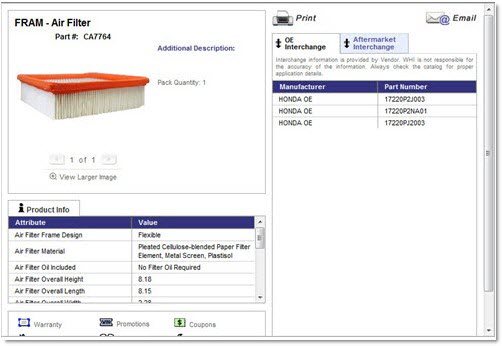
Displays a camera icon when a SmartPage is available. Left-click the icon to open the SmartPage.
If a part in the catalog has part detail information sent with the result, a camera icon will display in the catalog results.
Clicking the icon or the thumbnail image will open a web page showing the images.
The globe and camera icons both display when a part has both SmartLink and SmartPage.
Description
Indicates the part description.
When the 'Catalog Desc on Screen' field in the Store Catalog Options screen is checked:
-
The value in the 'Description' column in black text on the same row as the part number is the "catalog description", which is equivalent to the part type.
-
The first value below the part number row in black text is the "manufacturer label", which comes from the Catalog server and is a part description provided by the manufacturer. Only displays when the value is different than the 'Part Number' description that displays on the part 'Line'.
-
Attributes display in blue standard text and qualifiers display in blue italic text. Each part can have no attributes or any number of attributes.
-
POS Reminders display in red italic text. These are set up for each part in the Main Part Entry screen. Each part can have 0, 1, or many POS reminders.

-
Attributes and qualifiers that apply to a specific region, such as US or Canada, and/or position, such as Front or Rear, display with the heading of 'Position' or 'Region'. For parts that have an attribute note but no qualifier, the text 'Additional Fitments' displays for the qualifier.

When 'Catalog Desc on Screen' in the Store Catalog Options screen is unchecked, all information below the part number row displays the same as when the flag is checked with the following exception:
-
The value in the 'Description' column in black text on the same row as the part number is:
-
The inventory description from the parts/nonsku table, if one exists. (Displays in all CAPS.)
-
The "catalog description" (part type) if the part does not have a description in the parts/nonsku table.
-
The "catalog description" (part type) if the part is NIF.
-
Part Associations, such as alternates, supersedes, substitutions, and associations, always use the inventory description from the parts/nonsku table regardless if the 'Catalog Desc on Screen' field is checked or unchecked.
Displays the contents of the 'Bin' field from the part record, if available, when the column heading is 'Bin'. (Default).
Displays the 'GP%' value for each item found from the Catalog and Interchange lookup when the column heading is 'GP%'. The 'Invoice GP % On POS Screen' User Security proc is used to optionally display the 'GP%'.
Displays the value found in the 'Category' field in the Main Part Entry screen, or the value from the non-SKU record, if applicable.
The value of the 'Category Extra Column' field determines the column name that displays.
Per Car
Indicates the per car quantity supplied from the catalog lookup.
List
Indicates the manufacturer's suggested retail price for this part number. Displays for price comparison purposes.
Core
Indicates the base core price that is charged for this part number's core, if the part entered is a core part.
Each
Indicates the sell price that the customer is charged for this part number during this sale.
Range
Indicates the range of years that this part was used for the current vehicle model selected.
Qty
A drop-down that is at the top of the filter panel, allows filtering results based on the quantity available.
Options are:
-
'Include 0 Available' - Results will include parts regardless whether they have an available quantity or not. (Default)
-
'Available In Store' - Results will only include parts that have an available quantity greater than 0 in the store’' part record.
-
'Avail In Store/Sources' - Results will only include parts that have an available quantity in the store and/or at preferred sources.
Note: The 'Avail In Store/Sources' selection will only appear when the 'Include Preferred Source Stores in Catalog' is checked or 'DC / Other Source for Catalog' is specified in the Store Source Setup screen.
[Filter Panel]
Quickly filter parts in the catalog results using checkboxes in three sections: 'Brand', 'Part Type', or 'Position'.
-
Unchecked - When no checkboxes in a section are checked, no filtering is being done and all results are displayed.
-
Checked - When any checkbox in a section is checked, the results are filtered to only items matching the selected checkboxes.
[Part Count]
Displays the number of parts that were returned from the results.
When filtering is being used, displays the number of filtered parts out of the total number of parts returned from the search.
Response Time
Drop-down that displays the total response time for displaying items.
Breakouts for Catalog response time, PartsWatch stock check response time, and DC stock check response times are available by clicking the scroll-down arrow to the right of the field.
Item Count
Displays the number of items on the invoice.
Last Item Added
Displays the line code and part number of the last item posted to the invoice.
Qty
Displays the quantity of the last item sold.
Total Parts
Displays the total dollar value of parts posted.
Total
Displays the total dollar value of the invoice.
Catalog/Interchange Menu Icon
Click the Menu icon on an item row in the catalog results grid or the 'Interchange' window to display the following menu:
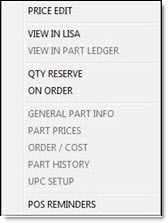
Total Details
Additional details of the total are available by clicking the 'Total' button.
The following pop-up displays. The pop-up may vary in size depending on the other items that affect the total. The 'Close' button closes the pop-up and returns to the Catalog screen.
When posting items from the Catalog is completed, return to Invoicing and add additional items to the Sales Order. If returning to Invoicing using the 'Back to Inv' button, and then returns to Catalog, then the last lookup displays.
Esc Key
The 'Esc' key also exits the CATALOG screen, however, 'Esc' does not have the same characteristics as the 'Back to Inv' button.
Press 'Esc' once to display the drop-down 'Group' selection list.
Press 'Esc' a second time display the 'Year' drop-down.
Press 'Esc' a third time to exit to the Invoice screen.
Additional Pop-ups During the Posting Process
Write-in Part
When attempting to sell an item that is a Not-In-File part number, the following pop-up may display depending on the value in the 'Allow W/I Parts' field Store Invoice Options screen.
If the 'Allow W/I Parts' field is set to 'Yes', a pop-up displays stating, "NIF part! Would you like to continue?".
Click 'No' to cancel the sale of the write-in part. Click 'Yes' to continue and to display the 'Price Edit' window.
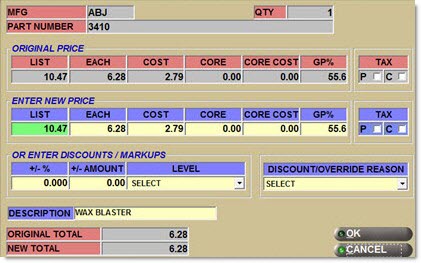
Once the 'Price Edit' window is completed, click 'Ok' to display the 'Insufficient Quantity' window.
Insufficient Quantity
When attempting to sell an item that does not have sufficient stock, the 'Insufficient Quantity' window displays.

Note: Refer to Quick Sourcing Help when Quick Sourcing functionality is enabled to allow sourcing directly from the 'Insufficient Quantity - Sourcing' window.
Lost Sale
A Lost Sale is an item requested by a customer at Point-of-Sale that was not available for sale. A lost sale can be recorded from the Invoice screen and the Catalog screen.
To record a lost sale from the Catalog screen, enter an 'L' in the 'Sell Qty' field and press the 'Enter' key. The program saves the parts and lost quantities to the sales order when the user returns to the Invoice screen from the Catalog screen. The lost sale is tracked in the Lost Sales Report. The 'Lost Sales' field in the Main Part Entry screen is updated with the lost sales quantity if the part is stocked in the store's inventory.
When a quantity is sold and a quantity is lost in the same sale, you must:
- Sell a quantity.
- Enter an 'L' on the same item in the 'Sell Qty' field to record the 'Per Car' or the default quantity of 1 if a 'Per Car' does not exist, and enters the quantity lost before or after the 'L' to record a lost quantity other than the 'Per Car' quantity or 1. For example, L5 or 5L.
When the Catalog screen is closed and the system returns to the Invoice screen, any parts that were selected as lost sales are updated to the sales order and the lost quantity is entered in the 'Lost' field. Lost sales entered in the Invoice screen from cataloging are processed the same as if they were entered from the Invoice screen directly. When the user does not wish to track a lost sale from cataloging as a lost sale, use the Manual Void (MV) modifier to void the part from the sales order.
Procedure to Record a Lost Sale Using the Default Quantity
To record a lost sale using the default quantity, follow the steps below:
-
Enter the Catalog screen from the Invoice screen.
-
Enter the parameters for the part lookup in the Catalog screen. The parts return.
-
Enter an 'L' in the 'Sell Qty' field and the quantity amount lost.
-
Press the 'Enter' key. The default sell quantity is tracked as the lost quantity. The part and lost sale quantity are stored.
-
Click 'Back To Inv'. The part is updated to the sales order. The 'Lost' field is updated with the lost sales quantity from the Catalog screen and tracked as a lost sale.
-
Click 'Cancel Order' or press the 'Esc' key to not print the invoice. The sales order is voided. The lost sale is stored until the screen is closed at which time the lost sale is processed as if 'Process' was clicked. The Lost Sales Report is updated.
Procedure to Record a Lost Sale and Sell a Part
To record a lost sale and sell another part, follow the steps below:
-
Enter the Catalog screen from the Invoice screen.
-
Enter the parameters for the part lookup in the Catalog screen. The parts return.
-
Enter an 'L' in the 'Sell Qty' field and the quantity amount lost.
-
Press the 'Enter' key. The part and lost sale quantity are stored.
-
Enter a quantity in the 'Sell Qty' field.
-
Press the 'Enter' key. The part is sold.
-
Click 'Back to Inv'. The lost sale part is updated to the sales order along with any parts with a sell quantity. The 'Lost' field is updated with the lost sales quantity from the Catalog screen and tracked as a lost sale.
-
Print the invoice. The lost sale is processed as if 'Process' was clicked. The Lost Sales Report is updated.
